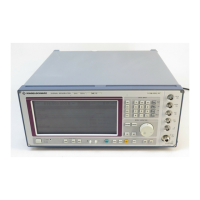Analog Modulations SME
1038.6002.02 2.70 E-13
DOWN FREQ
Input value of the modulation freq. of the antenna lobe arranged at the
bottom.
IEC-bus command SOUR:ILS:LLOB 150
Note: A variation of one of the two modulation frequencies
causes an automatic adaptation of the other modulation
frequency in such a way that a frequency-response ratio of
3:5 or 5:3 is maintained.
UP/DOWN PHASE
Input value of the phase between the modulation signals of the upper
and lower antenna lobe. The zero point of the 150-Hz signal serves as a
reference. The input is effected in degrees of the 150-Hz signal.
IEC-bus command SOUR:ILS:PHAS 0deg
ILS DEFAULT SETTING
Call the ILS-GS default setting. The default setting corresponds to the
setting represented in Fig. 2-34 except for the MODE setting (=NORM).
The selection of the CARRIER FREQ KNOB STEP parameter is not
changed by calling this function.
IEC-bus command SOUR:ILS:PRES
COM/ID STATE
Switching on/off an additional communication/identification signal
(COM/ID-Signal).
IEC-bus command SOUR:ILS:COM ON
COM/ID FREQUENCY
Switching on/off an additional communication/identification signal
(COM/ID-Signal).
IEC-bus command SOUR:ILS:COM:FREQ 1020
COM/ID DEPTH
Input value of the AM modulation depth of the COM/ID signal.
IEC-bus command SOUR:ILS:COM:DEPT 10PCT
DDM KNOB STEP
Input value of the AM modulation depth of the COM/ID signal.
DECIMAL Decimal variation according to the current cursor position.
DEFINED Variation between the predefined DDM values:
-0,4000
-0,1750 (Glide Sector)
-0,0910, 0,0450
0,0000 (Glide Path)
+0,0450, +0,0910
+0,1750 (Glide Sector)
+0,4000
CARRIER FREQ KNOB
STEP
Variation between the predefined DDM values:
DECIMAL Decimal variation according to the current cursor position..
DEFINED Variation in predefined steps according to the standardized
GLIDE-SLOPE transmitting frequencies (see table).
Note: If DEFINED is selected, the current RF frequency is
automatically switched over to the next GLIDE-SLOPE
transmitting frequency acc. to the table when switching on the
modulation.

